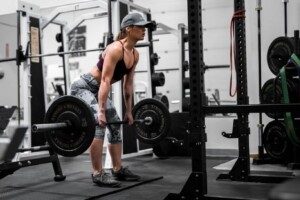
It’s not uncommon for men with enormous (wide) backs to be seen doing heavy deadlifts.
Some women may be concerned that doing deadlifts will give them a wide back, while some men will do deadlifts thinking that this is how to get a big, wide back.
Though deadlifts recruit back muscle, this is not the exercise to get a huge or even “big” or “wide” back. Trust me on that.
So if you’re a woman who’s been putting off doing deadlifts because you don’t want a wide back, fear no more, and start adding this exercise to your program.
Men who do heavy deadlifts are bound to have a wide, broad back – simply because anyone who performs heavy deadlifts also does heavy lifting in other routines as well! That’s a no-brainer.
The man with the huge back who warms up with a 225 pound deadlift is the same man who’d be doing a 200-pound, wide-grip lat pull-down, and super heavy loads with a wide grip seated row or standing barbell rows.
I do heavy deadlifts and dang, my back won’t get wider to save my life. For men who want a wide, broad, bigger back, do the following exercises:
Wide grip lat pull-down. The primary mover here is the latissimus dorsi, and when this muscle gets very developed, it’s what makes the back bigger and wider. The lat muscle is not the primary mover in a deadlift motion.

Wide grip pull-up. Again, the primary mover is the latissimus muscle.
Wide grip seated row. Latissimus muscle again.
Wide grip standing barbell row. Ditto.

Shutterstock/martvisionlk
The lat muscle is responsible for the joint actions of shoulder adduction and extension.
These joint motions occur during lat pull-downs and wide grip pull-ups. Seated rows and barbell rows involve shoulder extension and shoulder girdle retraction (lat muscle).
The deadlift is a multi-joint routine that can leave your back sore the next day, but in this compound exercise, there is no shoulder extension, shoulder adduction or true scapular retraction.
I say “true” because, to a minimal degree, there is some scapular retraction, but the range of motion is quite limited.
What gets hit hard with deadlifts is the lower back! The erector spinae muscles are resistant to hypertrophy (increase in size) because these are not force-production muscles, like the lats are.

Anastase Maragos/Unsplash
The erector spinae muscles are stabilizer muscles. Stabilizers are very resistant to increases in size.
Deadlifts also target the hamstrings and quadriceps, along with the upper trapezius.
It’s a whole-body movement, and thus, not the best exercise for massive size increases, including the back, though it’s excellent for other benefits.
 Lorra Garrick is a former personal trainer certified through the American Council on Exercise. At Bally Total Fitness she trained women and men of all ages for fat loss, muscle building, fitness and improved health.
Lorra Garrick is a former personal trainer certified through the American Council on Exercise. At Bally Total Fitness she trained women and men of all ages for fat loss, muscle building, fitness and improved health.
.

























